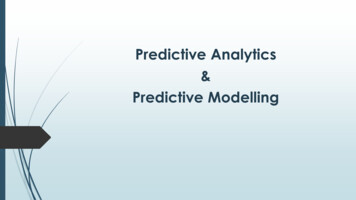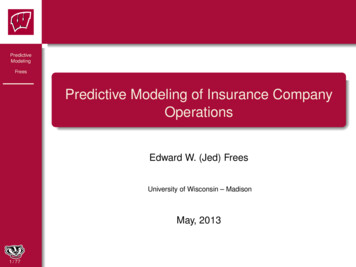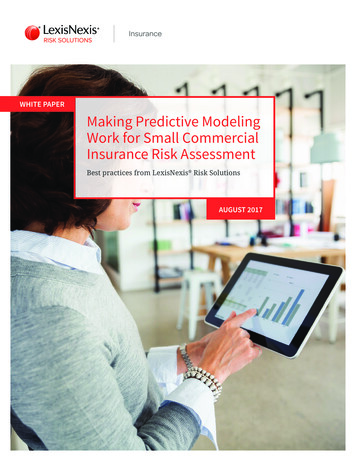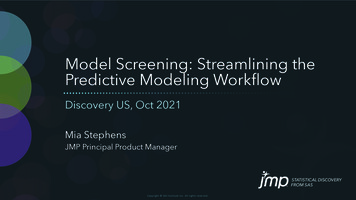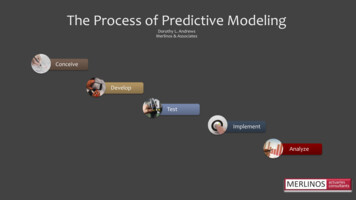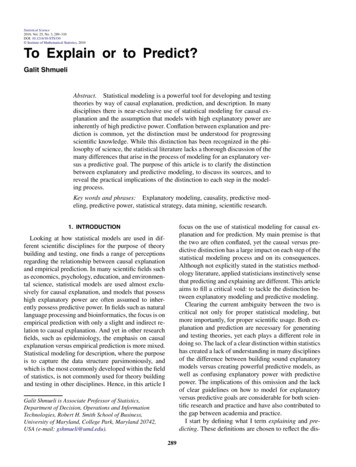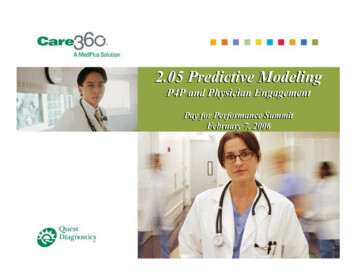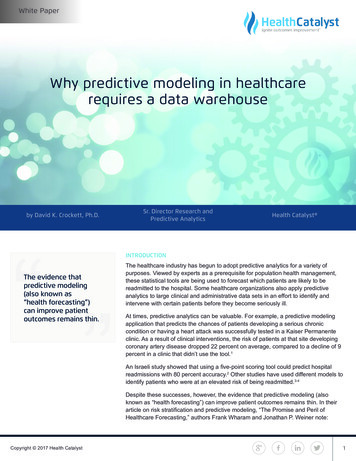
Transcription
Healthcare Quality Catalyst - Corporate Identity DesignWhite PaperHorizontal FormatWhy predictive modeling in healthcarerequires a data warehouseVertical FormatSingle Color - WhitePantone DS DS 232-1 UC: 100M: 0Y: 0K: 0Single Color - GrayPantone DS DS 220-2 UC: 80M: 30Y: 3K: 30 Pantone DS DS 325-3 UC: 0M: 0Y: 0K: 70Color Systemby David K. Crockett, Ph.D.Sr. Director Research andPredictive AnalyticsHealth Catalyst INTRODUCTIONThe evidence thatpredictive modeling(also known as“health forecasting”)can improve patientoutcomes remains thin.The healthcare industry has begun to adopt predictive analytics for a variety ofpurposes. Viewed by experts as a prerequisite for population health management,these statistical tools are being used to forecast which patients are likely to bereadmitted to the hospital. Some healthcare organizations also apply predictiveanalytics to large clinical and administrative data sets in an effort to identify andintervene with certain patients before they become seriously ill.At times, predictive analytics can be valuable. For example, a predictive modelingapplication that predicts the chances of patients developing a serious chroniccondition or having a heart attack was successfully tested in a Kaiser Permanenteclinic. As a result of clinical interventions, the risk of patients at that site developingcoronary artery disease dropped 22 percent on average, compared to a decline of 9percent in a clinic that didn’t use the tool.1An Israeli study showed that using a five-point scoring tool could predict hospitalreadmissions with 80 percent accuracy.2 Other studies have used different models toidentify patients who were at an elevated risk of being readmitted.3-4Despite these successes, however, the evidence that predictive modeling (alsoknown as “health forecasting”) can improve patient outcomes remains thin. In theirarticle on risk stratification and predictive modeling, “The Promise and Peril ofHealthcare Forecasting,” authors Frank Wharam and Jonathan P. Weiner note:Copyright 2017 Health Catalyst1
Health insurancecompanies, similarly,use actuarial riskmodels to compute thechances that particularindividuals will cost theinsurers more than theypay in premiums.There is little evidence regarding how or whether [health] forecastingimproves healthcare value. This is due to both the modest level of researchand what is termed the “impactibility” problem. That is, even if predictionalgorithms accurately identify at-risk patients, intervening to achieve desiredoutcomes is often inhibited by limitations of current disease managementapproaches or the general state of medical science.5This is a key point in any discussion of predictive analytics. Unless the resultsof health forecasting can be translated into effective interventions with individualpatients, the analytic tools will be useless. So healthcare organizations mustdevelop the infrastructure and the culture required to turn the data into action. Thatinfrastructure must provide the ability to generate timely reports and use automationtools to apply intervention strategies across a patient population.BACKGROUNDUsing computers to predict risks is not new. The Defense Department has longemployed predictive analytics to model nuclear war scenarios or optimize the order ofbattle. The life insurance and casino gaming industries have also invested heavily inprograms that help them calculate their odds of success.Health insurance companies, similarly, use actuarial risk models to compute thechances that particular individuals will cost the insurers more than they pay inpremiums. Until the Affordable Care Act took effect, health insurers utilized this typeof analysis to determine whom to exclude from coverage and how much to chargethe people they did cover. Some health plans have also been using it to intervenewith high-risk patients in disease management programs.6With the emergence of accountable care organizations (ACOs) and value-basedreimbursement, many hospitals and healthcare systems have also begun torecognize that they need predictive analytics and health risk stratification to managepopulation health and deliver care more cost effectively. At the same time, providerorganizations are now focused on reducing readmission rates so they won’t befinancially penalized by Medicare.The current interest in predictive modeling is part of a larger trend to employ businessand clinical intelligence (B&CI) applications in healthcare. Until recently, organizationsthat had the ability to mine and analyze data were mostly conducting retrospectiveanalyses.7-8 Today, as their analytic capabilities mature, a growing number ofhealthcare systems are adopting predictive tools. Most organizations, however,are either in the early stages of building data warehouses or are using standaloneanalytics for particular purposes without the infrastructure required to apply thesetools on a broader scale.9CHALLENGES FOR PREDICTIVE ANALYTICSPredictive algorithms enable computers to recognize patterns in data and drawdeductions from those patterns that show the likelihood of particular events occurringin the future. This kind of algorithm is used in many types of activities, ranging fromdetection of credit card fraud and the optimization of search engines to stock marketanalysis and speech recognition.To create a predictive algorithm, developers first define a problem, gather data, and runand evaluate different models to solve the problem. Next, they select the best modeland validate it. Finally, they test the model by running it against a real-world dataset.Copyright 2017 Health Catalyst2
To create a predictivealgorithm, developersfirst define a problem,gather data, and runand evaluate differentmodels to solve theproblem. Next, theyselect the best modeland validate it. Finally,they test the modelby running it against areal-world dataset.Figure 1: The Modeling ProcessTo improve the accuracy of predictive modeling, developers may take an approachknown as “supervised learning,” in which the outcome is known ahead of time andis used to “train” an algorithm. But in healthcare, many important kinds of patientoutcomes are not captured as structured data. Without outcomes data to train thealgorithm, it’s difficult to apply a supervised learning model.Some outcomes of interest can readily be measured. For example, if a predictor isdesigned to identify the patients who are at the highest risk of being readmitted, theoutcome is a readmission within a certain period of time. Similarly, if an algorithmpredicts which patients are most likely to have out-of-control hypertension or to benoncompliant with particular medications, those endpoints may be documented instructured data that can be analyzed.In contrast, the health status of patients after discharge may not be available unlesspatients fill out functional status surveys at specified intervals. Also, the follow-up onmost patients after discharge or between office visits is limited or nonexistent. As aresult, only the data generated in the EHR during a visit or an episode of care may beavailable. Diagnoses, lab values, medications, and vital signs from these encountersappear in a data warehouse, but they don’t reflect the time period between visits,which would show how the patient fared between visits or episodes.Even the episodic data are frequently not structured in the EHR, partly because someproviders don’t enter them in the ubiquitous pull-down check boxes. For example,studies have shown that patient diagnoses are often missing from discrete data,although they usually appear somewhere else in the record.10Paid claims data, in contrast, always include diagnostic and treatment codes.Moreover, claims data show the services and prescriptions that patients receivedfrom providers outside an organization or network. But claims have a built-in lagtime, so they’re not very good for predicting what might happen in the near future.Copyright 2017 Health Catalyst3
Furthermore, claims are not precise enough to describe in detail what has been donefor the patient in various care settings.A generic readmissionpredictor developed inhouse, for example, wasvalidated to performwith a 79 percentpositive predictivevalue (PPV). In contrast,a readmission predictordeveloped by HealthCatalyst and appliedto patients withcongestive heart failurehas a 91 percent PPV.For most analytic purposes, organizations rely on a combination of clinical and claimsdata, if they have access to the latter. ACOs, in particular, are expected to dependon claims data for years to come.11 But to make the best use of predictive analytics,healthcare organizations must build data warehouses capable of aggregating,normalizing and cleaning up this data and presenting it in a format that is easy to usein report generation.SPECIFICITY AND CLINICAL INSIGHTPredictive modeling is more accurate when it is applied to specific subpopulationsand care settings than when it is used generically across cohorts and organizations.A generic readmission predictor developed in-house, for example, was validatedto perform with a 79 percent positive predictive value (PPV). In contrast, areadmission predictor developed by Health Catalyst and applied to patients withcongestive heart failure has a 91 percent PPV. The latter model is more accuratebecause the variables it uses are more specific to the population involved. Inother words, the very features that characterize a specific condition well are thesame attributes that can train an accurate predictor. Additional information isavailable at ebinar.pdf.Figure 2: Specific Improves AccuracyA study by researchers at Emory University makes the same point in a differentway. The researchers used an algorithm to predict readmission of post-surgicalpatients to a children’s hospital based on three variables: how many days a patienthad been in the hospital, whether or not the patient had failed to thrive during thepre-operative period, and whether or not the patient was Hispanic. Researchersfound that these indicators predicted most readmissions to that hospital.12 However,this algorithm could only be applied to areas where there are a lot of Spanishspeakers, who are less likely to understand discharge instructions spoken or writtenin English.Copyright 2017 Health Catalyst4
TURNING INSIGHTS INTO ACTIONLink predictions to specificclinical priorities, such asraising the percentage ofhypertensive patients withblood pressure controlled.Set up new workflows anduse automation solutions totake advantage of predictiveanalytic insights.Apply analytics to slowlychanging clinical situations,not emergencies.Use analytic tools withlongitudinal rather thanepisodic data.To improve predictiveaccuracy, use patient dataobtained through surveysand remote monitoring.Build an advanced datawarehouse to integrate allavailable information on apatient in near real time.Ironically, even without fancy predictive analytics in use, any physician or nursewould recognize this language barrier difficulty. Similarly, they know that lowpatient literacy, poor understanding of discharge instructions, failure or inabilityto make an appointment with a primary care doctor, and lack of communicationbetween inpatient and ambulatory providers are all factors in readmissions.13-14What is needed to solve these problems is not analytics, but action grounded inclinical experience.Even where predictive analytics can help improve the quality of care, clinical insightis critically important to support and inform the use of these tools. Unfortunately thatinsight isn’t always available. For example, Northwestern University found that 30percent of their own patients under chronic condition management were unable toparticipate in treatment protocols. The reasons were related to cognitive, economic,physical or geographic inabilities, religious beliefs, contraindications to the protocol,and/or voluntary non-compliance. These atypical patients must be treated orreached in a unique way, and predictive algorithms, data collection strategies, andinterventions must be adjusted for their attributes. More information is available cal observations can also improve the accuracy of predictors. To illustrate, apatient wellness metric known as the Rothman index requires users to input notonly structured data such as lab values and blood pressure readings but also thenursing assessment of the patient.15 The predictor would be a failure without thenursing notes, because it would be an incomplete snapshot of the patient. But thecombination of the nursing assessment with the lab values and the vitals makes theRothman index fairly accurate.Predictive analytics, as noted earlier, is not very useful unless it can be applied topatient care to improve outcomes and efficiency. These tools, which might betterbe described as “prescriptive” analytics, should link predictions to specific clinicalpriorities, such as increasing the percentage of hypertensive patients who have theirblood pressure controlled. The predictors should also be focused on measureableevents, such as cost effectiveness, clinical protocols or patient outcomes.To use these tools successfully, healthcare organizations must be willing tochange their culture and their work processes. New workflows should be setup and organizations should deploy automation solutions to take advantageof the insights afforded by predictive modeling. Organizations must persuadeclinicians to trust analytics that have been proved valid for particular kinds ofclinical decisions.Because of the potentially serious consequences of making the wrong decision inan emergency, predictive analytics are sometimes easier to apply to slowly changingsituations such as chronic disease management, elective procedures, weaningpatients off ventilators, and antibiotic protocols.For optimal use in chronic disease management, predictive analytics should beapplied to longitudinal rather than episodic data. This requires getting patientsinvolved. For example, patients might be asked to fill out online functional statussurveys at regular intervals. In select healthcare settings, remote monitoring datamay also be routinely available. By feeding this kind of data into the predictivemodel for the target patient population over time, and analyzing it by age, gender,medication, geographical location, and other variables, researchers can developmuch more specific predictive models than they could with a general hospital orambulatory care population.Copyright 2017 Health Catalyst5
By accurately predictingwho is most likely toget sick, organizationscan set prioritiesand focus their caremanagement andpatient engagementactivities on the peoplewho need it the most.It is impossible to aggregate and normalize this information for analysis withoutan advanced data warehouse that allows continuous updating and flexible reportgeneration. To deliver actionable insights, moreover, this data warehouse mustbe able to integrate all of the available information on a patient in the context ofwhat clinicians want to know. In a rich EDW environment where patient details areavailable in this context and can be fed into a predictive tool, the interventions drivenby that predictor are more likely to be successful than they would be when a singlepurpose, point solution is applied to data in an information silo.Population health managementOne of the fastest ways to derive value from predictive modeling is to apply it topopulation health management. This involves a form of predictive analytics known asrisk stratification, which classifies patients by their risk of getting sick or sicker withinthe next year or some other time period.In population health management, the ability to do this is critical, because only 30percent of patients who are high-risk today were in that category a year ago.16 Byaccurately predicting who is most likely to get sick, organizations can set prioritiesand focus their care management and patient engagement activities on the peoplewho need it the most.In a 2013 Issue Brief published by the Colorado Beacon Consortium, Asaf Bitton,M.D., MPH, FACP, noted, “Risk stratification is an intentional, planned and proactiveprocess carried out at the practice level to effectively target clinic services topatients.” In that same Brief, the Consortium’s Executive Director, Patrick Gordon,identified three goals for risk stratification:Predict risksPrioritize interventionsPrevent negative outcomes (e.g., disability and death, as well as unnecessarycosts)17Risk stratification requires sophisticated algorithms, robust registries or datawarehouses, and the ability to integrate multiple sources of data. “The more data youhave, the better able you are to predict outcomes,” Gordon noted. “Access to moreactionable data within a process driven by clinical judgment and shared decisionmaking improves the ability of a practice team to proactively align resources withpatient needs.”18Administrative ApplicationsAn organization can also use predictive analytics to increase the efficiency ofcertain operations. For example, if there are certain disease patterns – such asbiannual outbreaks of upper respiratory infections in children or a spike in asthmaattacks triggered by worse air quality in certain seasons – algorithms can bedevised to help healthcare systems better manage their supply chain and staffing.19If an organization can predict changes in demand for services, it can ensure thatsufficient supplies are on hand or that nurse staffing is adequate take care ofpatients on a particular shift.Copyright 2017 Health Catalyst6
COMPARISON OF CURRENT SOLUTIONSSolutionOutsource analyticsto service firmsProsConsNo upfrontinvestment.Limited types ofanalyses.Can help improvereporting.Inability to adapttools to meetorganizationalneedsCan d analyticsfor ionsCan be used togenerate reports forMeaningful UseNo overall viewof patient careand costs. Can’tbe integratedinto broad ITinfrastructure.Subpopulationscan’t be analyzed.Analytics not robustor flexible.Views limited toEHR data.Highest degree offlexibility.Advanced datawarehouse solutionCan adapt tochanges inhealthcareenvironment.Longer lead timeto build optimalinfrastructure.Allows meaningfulclinicalinterventions.Healthcare organizations can approach the use of analytics solutions, includingpredictive analytics, in several different ways. One option is to outsource theirbusiness and clinical intelligence work to analytics service providers. This approach,which doesn’t require any investment in hardware, software, or internal expertise, canhelp providers improve their internal and external reporting and can enable them tobenchmark their performance. But the providers who outsource these functions arelimited in the kind of analyses they can perform and are unable to adapt the analytictools to meet their specific needs.Second, organizations can adopt “best of breed” point solutions. These standaloneapplications provide detailed analytics for a specific domain, such as readmissions,but don’t supply an overall perspective on patient care and costs. They also can’t beeasily integrated into a broader infrastructure that would increase their usefulness.Copyright 2017 Health Catalyst7
An approach basedon the use of anadvanced enterprisedata warehouse(EDW) provides thehighest degree ofanalytics flexibility andadaptability.A standalone predictive tool cannot be used to analyze the health risks ofsubpopulations because the data is not readily available. For example, unless anorganization leverages a data warehouse for predictive analytics, it can’t producecomprehensive reports on all patients over 65, all women who recently gave birth,or all people who went to the ER because they recently overdosed on drugs. Thewarehouse environment allows pertinent but disparate data sources to be mappedand combined. This is the kind of complete information that a predictor needs todistinguish the signal from the “noise” in the data and make accurate forecasts.Some healthcare organizations look to their electronic health record (EHR) vendorsfor analytics capabilities. According to a recent survey, more than half of the hospitalsthat use clinical and business intelligence employ the analytic modules embedded intheir EHR or hospital information system. Such tools can be used to generate reportsrelated to Meaningful Use objectives.20 But these analytics often lack robustnessand flexibility. In addition, the data they use comes solely from the EHR. As a result,the analytics lack an integrated view of clinical, financial, administrative, and patientsatisfaction data.Finally, organizations could build an optimal infrastructure for generating analyticinsights before deploying predictive analytics. Such an approach, based on the useof an advanced enterprise data warehouse (EDW), provides the highest degree ofanalytics flexibility and adaptability. It can drive an analytics strategy that will enablean organization to adapt to both short-term and long-term changes in healthcare.Most importantly, this rich EDW environment enables meaningful intervention ifthe organization connects its analytics to care management. More information isavailable at althcare-analyticssolutions-html.ANALYTICS ADOPTION MODELOrganizations that take the road to predictive analytics described above shouldstudy the Analytics Adoption Model that was developed by a group of healthcareindustry veterans, including hospital CIOs and healthcare consultants. This eightlevel model provides a road map for organizations to measure their own progresstoward analytic adoption.Level one of this schema consists of fragmented point solutions that are notintegrated with a data repository or with each other. In Level 2, organizations build anenterprise data warehouse (EDW) for clinical and administrative data with a mastervocabulary, a patient registry, and basic data governance.In Levels 3 and 4, providers begin to use the warehouse for automated internal andexternal reporting. Key performance indicators are visible to both frontline managersand executives. Analytics are used to produce reports required for regulatory andaccreditation purposes, specialty society databases, and payer incentives (e.g., theMeaningful Use EHR incentive program, the Physician Quality Reporting System,and the Medicare value-based purchasing program).The goal of analytics in Level 5 is to measure clinical effectiveness that maximizesquality and minimizes waste and variability. Data governance supports caremanagement teams involved in population health management. The EDW isexpanded to include clinical data from labs and pharmacies, as well as claims data.Level 6 is designed for organizations that take bundled payments and accountablecare organizations that share financial risk and reward. Analytics are available atCopyright 2017 Health Catalyst8
the point of care to help organizations achieve the Triple Aim of improving quality,efficiency, and the patient experience.In Level 7, analytics are further expanded to address fixed-fee reimbursementmodels (i.e., risk contracts). Predictive modeling and risk stratification are deployed tosupport population health management. Data sources include home-monitoring, longterm-care, and patient-reported outcomes data.Level 8 expands the role of analytics to include wellness management, physical andbehavioral functional health, and mass customization of care. Prescriptive analytics– a combination of insights from predictive analytics with clinical decision support –are available at the point of care to help clinicians determine which interventions areappropriate for each patient. In the future, the data content at this level will includecontinuous biometric data, genomic data, and familial data.HEALTHCARE ANALYTICS ADOPTION MODELData binding grows in complexity with each LevelTailoring patient care based on populationoutcomes and genetic data. Fee-for-qualityrewards health maintenance.Organizational processes for intervention aresupported with predictive risk models. Feefor-quality includes fixed per capita payment.Tailoring patient care based upon populationmetrics. Fee-for-quality includes bundled percase payment.Reducing variability in care processes.Focusing on internal optimization andwaste reduction.Level 8Personalized Medicine &Prescriptive AnalyticsLevel 7Clinical Risk Intervention &Predictive AnalyticsLevel 6Population Health Management& Suggestive AnalyticsLevel 5Waste & Care VariabilityReductionLevel 4Automated External ReportingEfficient, consistent production of reports &adaptability to changing requirements.Level 3Automated Internal ReportingEfficient, consistent production of reports &widespread availability in the organization.Level 2Standardized Vocabulary &Patient RegistriesRelating and organizing the coredata content.Level 1Enterprises Data WarehouseCollecting and integrating the coredata content.Level 0Fragmented Point SolutionsInefficient, inconsistent versions of the truth.Cumbersome internal and external reporting.Note that predictive analytics don’t emerge in this model until Level 7 (although theycould arguably be used in Level 6, as well). Organizations that attempt to leapfrogthe earlier levels in order to apply predictive tools will find their efforts hampered byan inadequate infrastructure. It is impossible to do predictive modeling, for example,before an organization even automates the reporting process in its EDW.ENTERPRISE DATA WAREHOUSINGTo use predictive analytics effectively for improving patient outcomes andmanaging population health, an organization must have an EDW. Yet by 2011, onlyapproximately 30 percent of U.S. hospitals and healthcare systems had an EDW;a 2013 report suggests that number hasn’t changed much.21-22 Moreover, the vastCopyright 2017 Health Catalyst9
majority of those EDWs use an antiquated architecture that isn’t flexible enough tomake the insights of predictive analytics actionable.To understand why, one must know the difference between “early-binding” and “LateBinding ” models for data warehouses.Data can be “bound” to business rules that are implemented as algorithms,calculations, and inferences acting upon that data. In healthcare, this data bindingmay be done for calculating the length of stay, attributing a primary care provider toa particular patient with a chronic disease, or data definitions of disease states forpatient registries, among other things. In addition, data can be bound to vocabularyterms such as patient identifier, provider identifier, location of service, gender,diagnosis code, and procedure code.Early-binding models, which characterize most legacy EDWs, are based on largesoftware programs that bind data to business rules or vocabularies before they arecompiled. By definition, these are static models. If the software must be modifiedbecause of new business rules or requirements, it is a very time- and labor-intensiveprocess that can take 12 to 18 months to complete in a large organization. By thetime the changes have been made for a specific kind of predictive modeling, the usecases may have changed, requiring a whole new set of modifications in the program.In a Late-Binding model, programs are broken down into modules or objects thatsupport particular business services and processes. These modules are assembledas needed at run time, rather than being compiled beforehand. By using this kindof architecture, an EDW can provide analytic value in days or weeks rather thanmonths or years. Such an approach allows organizations to adapt easily to changingrequirements. More information is available at althcare-analytics-solutions-html.The following fundamental principles apply for all data modeling, especially whenused in predictive analytics:The key to success in data warehouses is relating data, not modeling data.Data should be modeled only to the extent necessary.Data from various source systems should be leveraged directly to minimize theamount of data normalization required.Data models should be applied to mapped subsets of data, such as EHR,claims, prescription, cost, and patient satisfaction data.Some core data elements are fundamental to nearly all analytic use cases inhealthcare. Those elements can be bound early, but remaining data shouldbe bound to other terms and business rules later and only when required byuse cases.CONCLUSIONPredictive analytics are rapidly emerging as a “must-have” class of analytics tools thathealthcare organizations can use to manage population health, reduce readmissions,and improve patient outcomes. But providers should not have unrealistic expectationsof what these analytics can do. The type and quality of available data, includingoutcomes data, limit the usefulness of predictive analytics. In addition, organizationsmust couple these analytics with other tools, such as outreach and care managementapplications, to access the full potential of predictors in patient care.Copyright 2017 Health Catalyst10
Before deploying predictive modeling tools, healthcare systems should developsophisticated data warehouses. Studies over the past few years show that mostorganizations still have work to be done in this area, although the path to achievinghigh-functioning data warehouses is clear. While point solutions and outsourcingoptions are available, and some EHR vendors offer analytics packages as well,building an EDW that allows the rapid assembly of patient data in context offers themost flexibility and the greatest range of possibilities for using pr
Despite these successes, however, the evidence that predictive modeling (also . known as "health forecasting") can improve patient outcomes remains thin. In their article on risk stratification and predictive modeling, "The Promise and Peril of Healthcare Forecasting," authors Frank Wharam and Jonathan P. Weiner note: The evidence that
